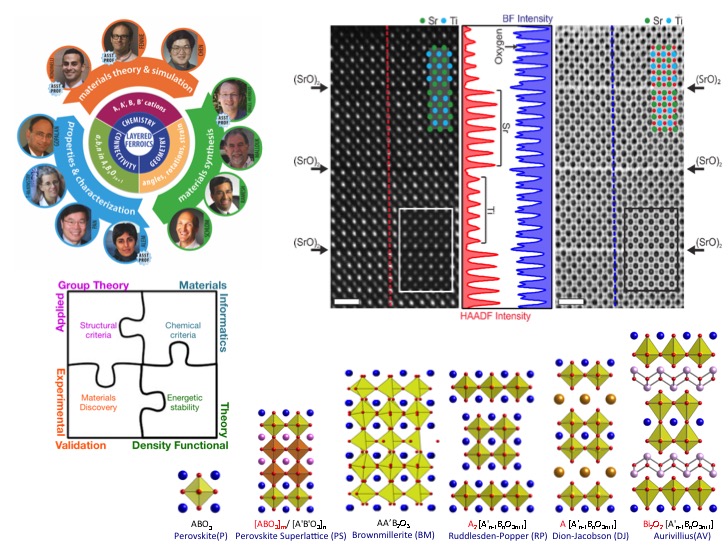
Leader: Venkatraman Gopalan
DESCRIPTION
IRG1, Designing Functionality into Layered Ferroics has, at its core, a Materials-by-Design challenge to design and discover multifunctional complex oxides starting from the level of atoms. The goal is to exploit the rich design space offered by layered oxides to poise them with competing coexistence of diverse polar, electronic, magnetic, and optical phenomena. An unprecedented expansion of ferroic families in layered oxides – a vast and largely unexplored materials class with unique control knobs in cationic chemistry, connectivity, and geometry – will enable us to counterpoise competing phases with colossal properties to transform otherwise nonpolar materials into strongly polar ones and will couple polar order parameter with metallicity, magnetism, correlated electronic phenomena, and optical transparency. Group theory, materials informatics, first-principles DFT, model Hamiltonians, and phase-field modeling will predict new ferroic systems and guide experimental efforts. Potential new technologies include high-temperature piezoelectrics, high-frequency tunable dielectrics for 5G networks, photovoltaics, and electric field control of metal-insulator transitions and magnetism.
RECENT ACCOMPLISHMENTS:
- Designed and Discovered many new families of noncentrosymmetric layered oxides. (Mayer, Adv. Functional Materials (2014), SenGupta, Adv. Electronic Material (2016), Benedek, Rondinelli, Dalton Transactions (2015), Young, Dalton Transactions (2015)), Li, Adv. Materials (2015)).
- Discovery of a new antisymmetry of motion and distortion of materials, (Vanleeuwen (2015)).
- Introduced a new paradigm for achieving optical transparency in correlated metals. (Zhang, Nature Materials, 2016).
- Discovered new polar vortex states in oxide superlattices (Yadav, Nature, 2016).
- Discovery of a low symmetry metastable phase with large property enhancements in classic ferroelectric crystals, BaTiO3 and KNbO3. (Lummen, Nature Commun., 2014).
- Discovery of a new family of improper acentric layered oxides, NaRETiO4, though oxygen octahedral rotations (Akamatsu, Phys. Rev. Lett., 2014).
- Prediction and discovery of a Ruddlesden-Popper layered ferroic with the highest figure of merit for dielectric tuning ever reported. (Lee, Nature, 2013).
- Three multiferroic mechanisms were discovered by our prior IRG team (2008-2014): Spin-phonon coupling (Nature 466, 954 (2010)), Coupled JT and DM interactions (Phys. Rev. Lett. 100, 167203 (2008)), and Hybrid improper multiferroics (Phys. Rev. Lett. 106, 107204 (2011)).IRG1 combines expertise in materials theory and simulation, materials synthesis, and physical property characterization to predict, discover, and characterize new ferroics with unprecedented properties based on layered oxides.

